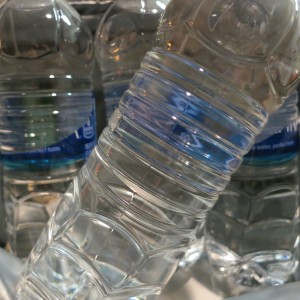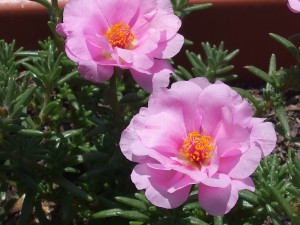KN, p. 177 “Did she die of heatstroke?”
It’s no secret that we’ve been doing a LOT of digging in the gardens this summer. The work can get hot and steamy, so we tend to start early in the morning. It’s not as humid and the bugs aren’t swarming in full force yet. Yesterday, I was delayed getting out there, so before I realized it, the sun was high in the sky, it was 95 degrees, I was really hot, and I was sweating something fierce.
And, suddenly thirsty. I was even a little dizzy and felt a headache coming on. As soon as I figured out what was happening, I dropped the tools and got myself inside. Sheila saw me ditch the shovel and headed in as well. I grabbed a cold, wet towel for my neck and she handed me some water. There was some scowling, but the crisis was averted.
What had happened? The heat got too much for me and I needed a tall, cool glass of water. I had left my golf cap inside, along with my bottle of water and my golf bandana, and I was paying for it. It didn’t get as far as heatstroke, but if I’d been at the golf course or the beach, and not 15 seconds from help, it could have.
The Mayo Clinic defines heatstroke:
“Heatstroke is a condition caused by your body overheating, usually as a result of prolonged exposure to or physical exertion in high temperatures. This most serious form of heat injury, heatstroke can occur if your body temperature rises to 104 F (40 C) or higher. Heatstroke requires emergency treatment.”
In the summertime, when temperatures reach in the high 90s on a regular basis, we will normally feel hot outdoors, so how do we know that there is a problem? Athletes, moms, dads, dogs, babies – everyone is vulnerable to heat stroke and we need to be aware of the symptoms.
Symptoms of Heat Stroke
Nobody I know carries around a thermometer, so aside from the high body core temp, symptoms can include:
- Nasty headache
- Dizziness
- Lack of sweating
- Red, hot, and dry skin
- Muscle weakness or cramps
- Nausea
- Rapid heartbeat
- Trouble breathing
- Disorientation, or staggering
How do we prevent things from getting to that point? Especially if you or your friends are planning to be out hiking, working, or camping in the heat, far away from speedy help?
Preventing Heat Stroke
- Wear lightweight, loose-fitting clothing, and a hat.
- Use a sunscreen with a sun protection factor (SPF) of 30 or more.
- Drink water – a half ounce for each pound of body weight – if you weigh 150 pounds, you should be drinking 75 ounces of water – and that’s on a regular day with no exercise or extra heat involved.
- Increase that amount if it’s hot outside or you are working/exercising outside.
- Drink an extra bottle of water an hour before exercise, then during exercise, drink another 8 ounces of water every half hour, even if you don’t feel thirsty.
- Shift your outdoor activities to the coolest times of the day, either early morning or after the sun goes down if you can. If not, make sure to follow the rest of the suggestions.
People die from heat stroke. That’s why we are warned not to leave children and pets in hot cars. When it’s hot outside, the heat in the car gets magnified by the windows, resulting in temperatures that can be 30 degrees hotter inside the car – a disaster waiting to happen.
Sporting events are times where people get caught up in the competition and forget to hydrate, sometimes with tragic consequences. At the time the article below was published, the softball player’s death was unexplained, but later pointed to heatstroke. What do you think?
http://weartv.com/news/local/questions-of-heat-stroke-raised-after-preteens-death
I always pack a bandana or ‘cold collar’ in my golf bag, wear a hat on the course, and take plenty of water with me. I got careless at the house, but that won’t happen again.
For additional information:
https://www.drugs.com/health-guide/heat-stroke-hyperthermia.html
*Photos by Patti Phillips
KN, p. 177 “Did she die of heatstroke?” Read More »








